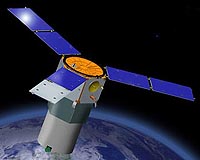 |
Paris, France (ESA) Jun 08, 2009 ESA's Planck satellite has caried out a critical mid-course manoeuvre that placed the satellite on its final trajectory for arrival at L2, the second Lagrange point of the Sun-Earth system, early in July. The manoeuvre began at 19:28 CEST on 5 June 2009, and lasted 30 hours. Planck's main thrusters conducted repeated 'pulse burns' during this time, switching on then off for 6 seconds every minute. This pulse-burn technique is necessary because Planck is slowly spinning as it travels through space, rotating at 1 rpm. The thrusters, which are fixed to the spacecraft and are not steerable, can only burn when they are oriented in the correct direction, which occurs for 6 seconds during each 60-second rotation.
Manoeuvre provides mid-course correction "Throughout the manoeuvre, we closely monitored the spacecraft behaviour and its dynamical state. Once the manoeuvre was complete the Flight Dynamics team analysed the burn performance and determined Planck's new orbit. Based on the results, we also have a slot available for a 'touch-up' manoeuvre on 17 June," says Matthias Muck, Planck Flight Dynamics specialist at ESOC, ESA's European Space Operations Centre, in Darmstadt, Germany. Muck says the manoeuvre is programmed to slightly undershoot the actual desired end-speed, so the touch-up manoeuvre on 17 June will probably be necessary to provide a final 5- to 10-m/s correction.
Orbit insertion manoeuvre planned early July This weekend's critical activity will be conducted by the Planck Flight Control Team at ESOC, supported by Flight Dynamics specialists, industry representatives and other experts. Named after the German Nobel laureate Max Planck (1858-1947), ESA's Planck mission is the first European space observatory whose main goal is the study of the Cosmic Microwave Background - the relic radiation from the Big Bang, with an accuracy defined by fundamental astrophysical limits. Share This Article With Planet Earth
Related Links L2, the second Lagrangian Point Space Technology News - Applications and Research
 Raytheon Hyperspectral Imaging Sensor Activated For Year-Long Mission
Raytheon Hyperspectral Imaging Sensor Activated For Year-Long MissionEl Segundo CA (SPX) Jun 08, 2009 Raytheon has received confirmation from the U.S. Air Force Research Laboratory that its hyperspectral imaging sensor known as ARTEMIS has been activated aboard the TacSat-3 spacecraft and is fully functional. The milestone continues Raytheon's 40-year history of on-orbit success. Activation also marks the beginning of the year-long TacSat-3 mission to test the payload's ability to deliver ... read more |
|
| The content herein, unless otherwise known to be public domain, are Copyright 1995-2009 - SpaceDaily. AFP and UPI Wire Stories are copyright Agence France-Presse and United Press International. ESA Portal Reports are copyright European Space Agency. All NASA sourced material is public domain. Additional copyrights may apply in whole or part to other bona fide parties. Advertising does not imply endorsement,agreement or approval of any opinions, statements or information provided by SpaceDaily on any Web page published or hosted by SpaceDaily. Privacy Statement |